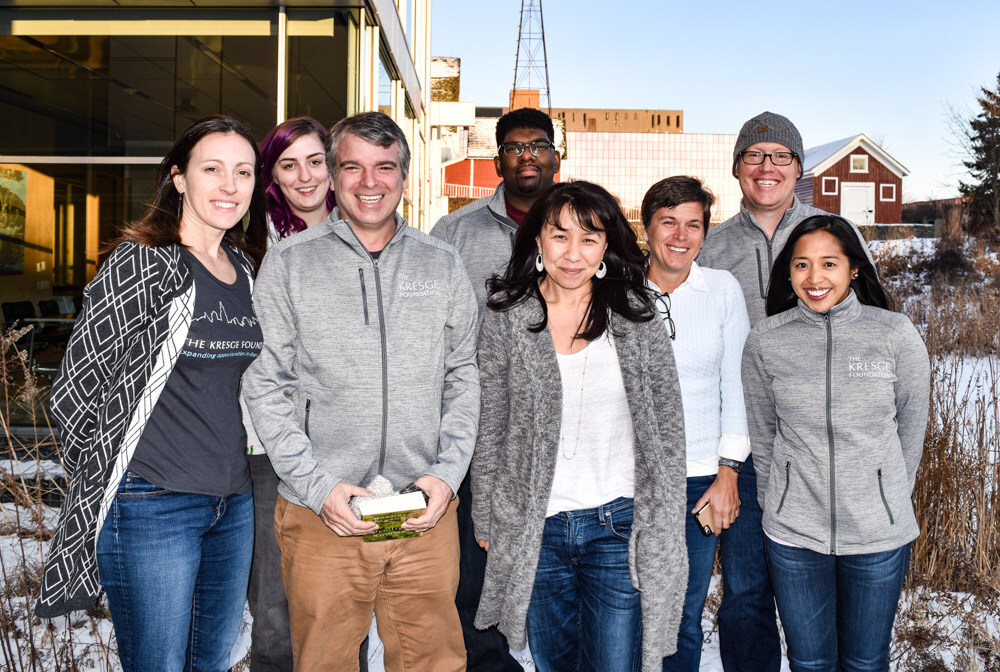Kresge Foundation supports Impact Investing and Diversity Fellowship program


Kresge’s Social Investment Practice typically makes multi-million-dollar investments that both further our goals to expand opportunity for low-income people in America’s cities and return capital to the foundation to be recycled for another social purpose.
But our team also makes grants, and in 2018, we granted money to Net Impact to support its inaugural Impact Investing and Diversity Fellowship program. We funded this program because Kresge has a commitment to racial equity, and we see that the world of impact investing professionals is not as reflective of the communities we’re trying to serve as we’d like it to be.
It’s little help that there’s no common route to becoming a social impact investor. Given the relative nascency of our field, people come to this work from a variety of places. We can see this on our own team, which is made up of people who worked for a community development financial institution (CDFI), a bank, a tax credit syndicator, a financial services company and as a consultant to other impact investors. Our degrees are in law, public policy, organizational development, philosophy and even writing and rhetoric! Not one of us started our careers knowing we’d wind up at Kresge, investing $350 million through debt, equity investments, and guarantees.
For under-represented or low-income people who want to explore this career on social impact and impact investing, there are other barriers to navigate. For example, there is unequal access to our higher education system, where you could start to explore the fundamentals of a career in finance. Also, most banking products and services are not created with low-income clients in mind. And, because the products that do cater to this community can be exploitive in nature, this relationship rarely carries a positive connotation.
Finally, there is often a prevailing belief that investing is not for the everyday person, but exclusively for the wealthy. Money, simply put, can feel out of reach. It’s hard to dream of a career where you would have access to invest millions toward social change if you simply cannot conceive that the financial markets can be a tool for social good.
We believe this fellowship program can help to overcome these barriers and contribute to the creation of a more diverse talent pipeline for our field. And we want more young people of all backgrounds to imagine a career in impact investing. I get asked often for advice on how to get started and was honored to have the opportunity to speak with the fellows on this very topic. Here are five things I share when that question pops up:
1. Study up on the fundamentals of capital. You need to understand how money works. You can approach this learning through coursework in economics, finance, accounting or business. It will always be necessary to know the basics of how capital flows.
2. No need to worry about being a math genius. You don’t have to be good at math – really! I don’t do calculus in my job. The most complicated math I do is various forms of arithmetic – e.g. calculating interest rates or changes in revenues or expenses over time; all things you can do on a (non-scientific) calculator.
3. The numbers tell a story, and your job is to find it. While calculus isn’t essential, this is. You must be able to look at a balance sheet and an income/profit and loss statement and understand the underlying financial story of that nonprofit or business. This is the beginning of your analysis on an investment opportunity. Certainly, impact investing has a qualitative component, in that we’re always thinking about the social impact outcomes we want to achieve. However, we do not skimp on the rigor involved in the financial analysis. And, as a bit of a numbers geek, I love this part of the job!
4. Seek out the sector that is meaningful to you. There are a lot of ways to do good in the world and make an impact. So, pick an area you love – whether that’s housing, food, education, water, climate, sustainability, sustainable agriculture, or something else. Investing for impact crosses most sectors. Having an authentic connection to an area of interest will make the work more enjoyable and fulfilling and, if you build up a bank of knowledge in that area, it will also make you more marketable.
5. Finally, get your feet wet through on-the-ground internships or early-career jobs. CDFIs are great places to learn (I spent ten years of my career at a one!) You could also explore a bank credit training program. Or, does your local community bank, CPA firm, or the accounting department of a local nonprofit offer an internship? See where you can learn how capital flows in the real world.
The bottom line is the impact investing field needs people of all backgrounds to participate and contribute to investment decisions that will best serve communities that the mainstream capital markets tend to overlook. And, I’m excited to see what contributions this first class of Impact Investing and Diversity fellows will make toward this goal!
Kim Dempsey serves as deputy director of the foundation’s Social Investment Practice. Follow the team’s work on Twitter @kresgesocinv.



